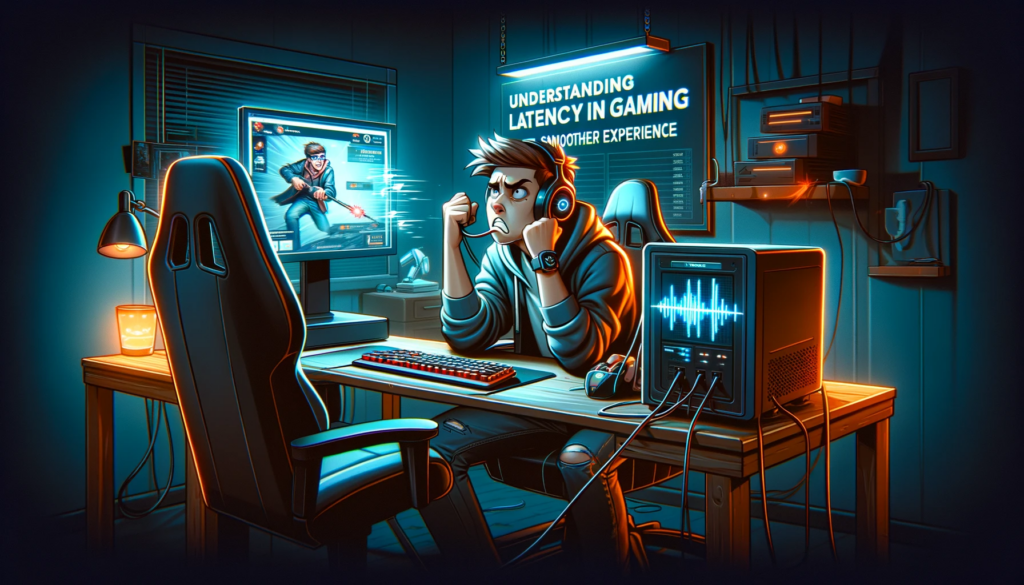Latency in gaming, a term as dreaded as an end-game boss, is the technological gremlin that turns our seamless gaming adventure into a herky-jerky nightmare. But what is latency in gaming, and how does it sneak into our gaming realms?

What is Latency in Gaming?
Latency, often used interchangeably with ‘ping,’ is when your gaming command travels to the game server and back. Think of it as a digital round trip. The faster the trip, the smoother your gaming experience. In an ideal gaming world, latency would be non-existent. However, in the real world, it’s the difference between triumphantly shouting “Victory!” and frustratingly mumbling “I hit that button in time.”
The Ideal, the Acceptable, and the Unbearable: Latency Ranges
Latency, a key factor in gaming, can greatly affect your gaming experience. It’s measured in milliseconds (ms) and represents the time a signal travels from your device to the game server and back. The latency range can be classified into various categories, each impacting gameplay differently:
- The Dream Zone (0-20 ms): This is the ideal range for competitive gamers. At this level, actions are almost instantaneous, offering an exceptional gaming experience. It’s crucial for fast-paced games where every millisecond counts, such as first-person shooters and racing games.
- Smooth Sailing (20-50 ms): In this range, the latency is still low enough that most gamers won’t notice any delay. The gaming experience remains smooth, making it suitable for various games, including most multiplayer online games.
- The Annoyance Begins (50-100 ms): As latency increases, delays become noticeable, especially in genres requiring quick reflexes. It can affect competitive gameplay and be a disadvantage in fast-paced action games.
- Lag City (100-200 ms): In this latency range, lag becomes a significant issue, disrupting the fluidity of gameplay. It could be more problematic in online games where timing and quick reactions are essential. Players might experience “rubber-banding” or delayed responses to their actions.
Game Over (200+ ms): At this level, the lag is so severe that games become difficult to play effectively. It leads to a highly unsatisfactory gaming experience, where players might struggle with severe delays and unresponsive controls.
Each range of latency has a distinct impact on the gaming experience. The lower the latency, the better the gameplay experience, particularly in genres that rely heavily on quick reactions and precision. Understanding these ranges can help gamers optimize their setup and choose the right games and servers to play on.
The Culprits Behind High Latency
Certainly! Let’s dive deeper into the factors that contribute to high latency in gaming, each acting like a cog in the wheel, slowing down the ultimate gaming experience.
Not Enough Internet Bandwidth
Bandwidth is the volume of information per unit of time your internet connection can handle. Imagine it as a highway; the more lanes (bandwidth) you have, the more traffic (data) you can accommodate smoothly. When the bandwidth is insufficient, it’s like squeezing a six-lane traffic jam into a single lane – chaos ensues, leading to data congestion and increased latency in gaming.
This scenario resembles trying to fit an elephant through a cat flap. To counter this, upgrading to a higher bandwidth plan is often recommended.
Slow Internet Speed
Internet speed, measured in Mbps (megabits per second), is the speed at which data travels from the internet to your gaming device and vice versa. Slow internet speeds can cause a significant delay in the transmission of game data. It’s like trying to run through molasses in January – everything moves painfully slowly.
Factors such as your ISP, the type of internet connection (DSL, cable, fibre), and network congestion can affect this. Upgrading to a faster internet connection or optimizing your current setup can help reduce latency caused by slow speeds.
Overworked GPU
The GPU (Graphics Processing Unit) is critical for rendering the visuals in your game. An overworked or underpowered GPU can be a bottleneck, slowing down the rendering process and, subsequently, the game’s responsiveness.
This situation is similar to asking a sprinter to run a marathon. The solution lies in optimizing your graphics settings or upgrading your GPU to match the demands of the games you play.
Distance from Server
The physical distance between your gaming device and the game server significantly impacts latency. Data packets must travel a longer distance, increasing response times. It’s like sending a letter across the world versus across town – the further the distance, the longer it takes. Selecting game servers closer to your geographic location can help reduce this latency.
Understanding these culprits is key to diagnosing and improving high latency in gaming. By addressing these factors, gamers can enhance their online gaming experience, making it more responsive and enjoyable.

Battling the Beast: Tips to Tame Latency
Battling latency in gaming is akin to fine-tuning a high-performance sports car: every tweak and adjustment can lead to a smoother, more responsive experience. Here are the tips to tame latency, drawn from multiple sources:
Choose the Right Server:
The distance between your gaming device and the game server is a critical factor in latency. Data packets have to travel this physical distance, so the closer the server, the shorter the trip and the lower the latency. Most games automatically connect you to the nearest server, but sometimes, you might need to choose manually.
Bid Farewell to VPNs and Proxies:
While VPNs and proxy servers offer security and anonymity, they can harm gaming latency. It is because they route your internet connection through additional servers, which can increase the distance data has to travel, thereby adding latency.
Disabling VPNs and proxies can directly connect your system to the game server, reducing the number of stops and potentially lowering latency.
Update Your Network Driver:
Network drivers enable your gaming device to communicate with your network and the internet. An outdated or malfunctioning network driver can lead to increased latency, packet loss, or even disconnections.
Regularly updating your network driver ensures it communicates efficiently with the operating system, potentially reducing gaming latency.
Switch to a 5GHz Wi-Fi Connection:
Wi-Fi operates on two main frequencies: 2.4GHz and 5GHz. The 5GHz band is generally less congested and offers higher data transfer speeds than the 2.4GHz band. While 5GHz has a shorter range, it can significantly reduce latency for gaming, especially if your gaming setup is close to the router.
However, it’s important to note that not all routers support 5GHz, so you might need to check with your ISP or consider upgrading your router.
Implementing these strategies can lead to a noticeable improvement in your gaming experience by reducing latency. Each of these steps addresses a different aspect of your gaming setup, and together, they can help ensure your gaming sessions are as lag-free as possible.
Frequently Asked Questions:
What is a good latency for gaming?
Aim for below 20ms for a near-perfect experience, but anything under 70ms is generally good for gaming.
Can my choice of internet connection type affect latency?
Absolutely! Fiber optics usually provide the fastest speeds, followed by cable and then DSL.
Wrapping It Up
In the end, latency in gaming is like an uninvited guest at a party – annoying but manageable. By understanding what causes it and how to reduce it, you can turn the tide in your favour and keep your gaming experience as smooth as that epic game-winning move you’re so proud of.
So, next time you’re in the heat of an online battle, remember that your skills are only as sharp as your connection speed. Here’s to lag-free gaming victories!


![The ‘Giveaway Piggy Back Scam’ In Full Swing [2022]](https://www.cjco.com.au/wp-content/uploads/pexels-nataliya-vaitkevich-7172791-1-scaled-2-683x1024.jpg)

